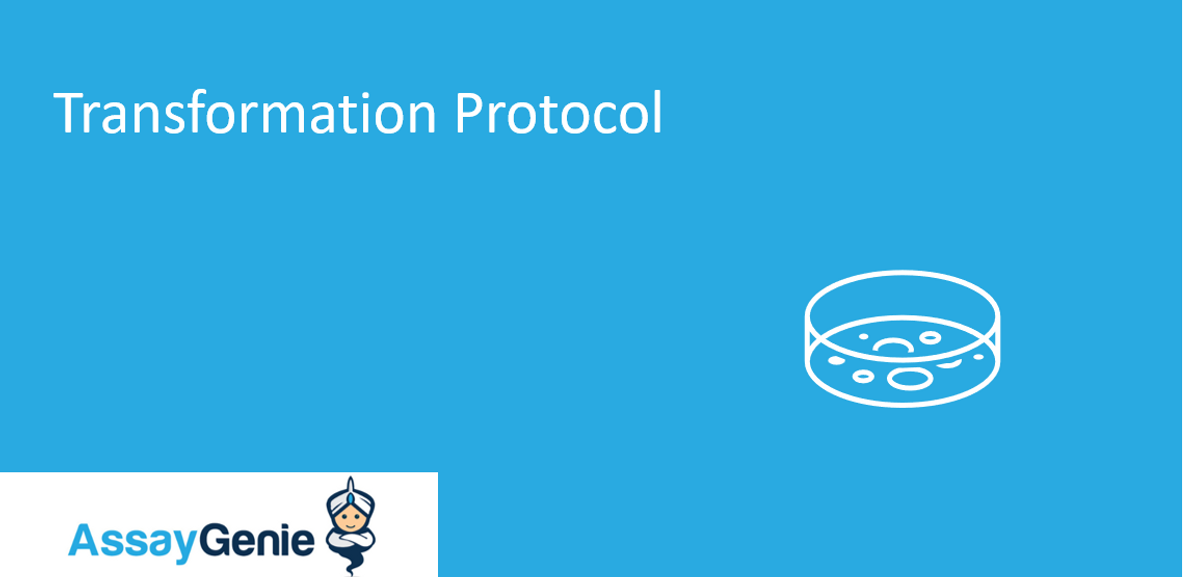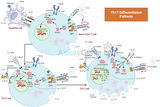Transformation Protocol – Sample Transformation Protocols
Introduction
Transformation of bacteria with plasmids is not only of note for bacterial studies but also can be used for gene expression studies in mammalian cells. Most plasmids are of bacterial origin and contain both a bacterial origin of replication and an antibiotic resistance gene which can be used as a selectable marker. The process of transformation allows foreign DNA to be introduced into a cell.
Genetic modifications can be made to various bacterial strains to make them more amenable to transformation. Such modifications will maintain the plasmid without rearranging the plasmid DNA. Certain treatments have been shown to increase the transformation efficiency of bacteria. These treatments make them more susceptible to either chemical or electrical based transformation, generating what are commonly referred to as 'competent cells.'
To enhance the transformation efficiency of bacteria, pre-incubation steps can be incorporated before the actual transformation process. Pre-incubation involves subjecting the bacterial cells to specific growth conditions or inducing stress, which enhances their ability to take up foreign DNA. By carefully optimizing these pre-incubation steps, researchers can significantly improve the efficiency of bacterial transformation, allowing for better results in downstream applications.
Key Takeaways:
- Bacterial transformation involves introducing foreign DNA, such as plasmids, into bacteria, critical for studies in gene expression and bacterial genetics.
- Pre-incubation steps and competent cell preparation enhance transformation efficiency.
- Practical protocols and equipment for transformation vary depending on the specific bacteria and DNA involved.
A Plasmid Map
Transformation in practice
The ability to selectively isolate, amplify, and propagate selected DNA sequences is fundamental in biology, offering a wide range of practical applications beyond the well-known cloning examples like Dolly the sheep. By harnessing the two classical traits of bacteria, Plasmids and Restriction endonucleases, DNA cloning enables the amplification of desired DNA sequences.
Plasmids, commonly found within bacteria, possess several advantageous characteristics for cloning purposes. They can autonomously replicate separate from chromosomal DNA, are typically double-stranded and circular in structure. This circular nature makes them ideal for accepting foreign DNA, resulting in the formation of recombinant plasmids. These recombinant plasmids contain a mixture of their own DNA and the selected DNA segment to be amplified. Additionally, plasmids carry essential components such as a restriction endonuclease, an origin of replication, and a selectable marker, such as kanamycin or ampicillin resistance.
Following the formation of recombinant plasmids, they can be introduced back into the bacteria through a process called transformation. Typically, this is achieved by rendering the bacterial cells competent, often through the application of heat shock. This technique weakens the cell membrane, facilitating the uptake of the recombinant plasmids by the bacteria.
After transformation, the bacteria can be screened or selected for the successful uptake of the plasmid or vector. This is commonly achieved by plating the bacterial broth on agar. For instance, let's consider a scenario where the gene of interest is the IL-18 promoter. This promoter can be inserted into the LacZ gene on the plasmid, which encodes for β-galactosidase. Normally, β-galactosidase can break down X-Gal, resulting in blue-colored colonies. However, if the gene of interest is successfully inserted, it disrupts the expression of β-galactosidase, causing the colonies to appear white in color on the agar plate.
By expanding upon these established techniques, researchers can harness bacterial transformation protocols to manipulate and amplify specific DNA sequences for various applications in biological research and beyond.
Equipment/Materials needed for transformation
*These can vary depending on transformation protocol
- Competent cells
- LB Agar
- SOC media
- Antibiotic (Kanamycin/Ampicillin)
- Spreader
- Culture dish
- Shaker incubator at 37 °C
- Cabinet incubator at 37 °C
- Water bath at 37 °C
- Centrifuge
- Ice
The Preparation of chemically competent cells (Sample protocol 1)
- Escherichia coli strain DH5 Alpha was used to amplify plasmid DNA
- Cells were made competent by the calcium chloride method.
- Untransformed DH5 Alpha was streaked onto LB (Luria Bertani) agar (10g/L tryptone, 5g/L yeast extract, 10g/L NaCl, pH 7.0), supplemented with 15g/L agar and incubated overnight at 37 °C.
- A well defined DH5 Alpha colony was then picked from the LB agar plate and grown overnight in 5 ml LB (10g/L tryptone, 5g/L yeast extract, 10g/L NaCl) while shaking at 200rpm.
- 1 ml of the overnight culture was then diluted to 150 ml with LB and grown until an OD600 of 0.4 to 0.6 was achieved.
- Cells were harvested by centrifugation at 800 g for 10 min at 4 °C
- Re-suspend in 10 ml of ice-cold, sterile 0.1 M CaCl2 and incubate on ice for 5 min.
- Following re-centrifugation the cells were re-suspended in 2 ml of 0.1 M CaCl2 and 70 µl of DMSO added.
- Cells were re-incubated on ice for 15 min. 200 µl aliquots were stored at -80 °C.
Transformation protocol for competent E.Coli cells (Sample protocol 1)
- Frozen competent cells were thawed on ice.
- 100 µl aliquots of bacteria were thawed.
- 2 µl of the desired plasmid was then added and the cell/plasmid mixture was incubated on ice for 30 min.
- Plasmid uptake was induced by heat-shocking the cells at 42 °C for 40 seconds, followed by recovery on ice for 2 minutes.
- 500 µl of LB was then added and the cells were incubated for 1 h under low agitation (220 rpm) to allow for expression of the antibiotic resistance gene.
- 100 µl aliquots of cells were plated on LB agar plates containing ampicillin (100 ׬g/ml) to select for transformants harbouring the plasmids.
- Dishes were inverted and incubated overnight at 37 °C.
Preparation competent E. coli cells (Sample protocol 2)
- A single colony of coli XL1 was inoculated into 5 ml LB medium and cultured on a shaker at 37 °C overnight.
- The 5 ml culture was added to 100 ml LB medium in a sterile 250 ml flask and cultured on a shaker at 37°C until the absorbance at 600nm (OD600nm) reached 0.6 AU.
- The culture was transferred to 50 ml tubes and cooled on ice for 10 min.
- The samples were centrifuged at 1700 RCF for 10 min and the supernatant was removed.
- The bacterial cell pellet was used to prepare glycerol stocks by resuspending the pellet in 2 ml 40% glycerol in dH2O.
- 100 μl was aliquoted into 1.5 ml tubes and snap-frozen using liquid nitrogen and stored at -80 °C.
- Before transformation with plasmid DNA, a glycerol stock of coli XL1 was removed from the -80 °C storage and was made competent by pelleting the cells by centrifugation at 2700 RCF for 5 min.
- The supernatant was removed and the pellet was resuspended in 10 μl of TfbI Buffer (30 mM potassium acetate, 100 mM rubidium chloride, 10 mM calcium chloride, 50 mM manganese chloride, 15 % (v/v) glycerol, pH 5.8 with acetic acid, filter sterilised) and incubated on ice for 15 min.
- The suspension was centrifuged at 2700 RCF for 5 min and the supernatant was removed and the pellet was resuspend in 10 μl of TfbII Buffer (10 mM MOPS, 75 mM calcium chloride, 10 mM rubidium chloride, 15 % (v/v) glycerol, pH 6.5 with NaOH, filter sterilised).
Transformation of competent E. coli (Sample protocol 2)
- Competent coli XL1 cells (10 μl) as prepared above (Preparation competent E. coli cells (Sample protocol 2) were incubated with 2 μl of plasmid DNA and placed on ice with occasional mixing for 30 min.
- The samples were heat shocked in a 37 °C water bath for 2 min then transferred to ice.
- The cells were then added to 1 ml of LB broth and placed on a shaker at 37 °C for 60 mins, followed by centrifugation at 3000 RCF for 3 min.
- The supernatant was removed leaving 100 μl and the pellet was resuspended in the remaining supernatant.
- An aliquot (100 μl) of the sample was spread onto a LB agar plate containing 30 μg/ml kanamycin and incubated overnight at 37 °C.
Following expansion overnight the bacterial cells can be pelleted by centrifugation and the plasmid purified from E. coli. The plasmid DNA can then be quantified using Multi-Sample Micro-Volume UV-Vis Spectrophotometer NanoDrop 800 or a similar piece of equipment. The DNA can be stored at -20°C for short term or -80°C for long term storage
Hints and Tips
1. Temperature– Temperature plays a very important role in transformation and can greatly effect the efficacy of your experiment. The correct temperature is essential at three stages Thawing, the incubation of DNA with cells on ice and during heat shock.
- Thawing– The cells are best thawed on ice. The cells can be thawed by hand but warming above 0 °C decreases efficiency. As soon as the last trace of ice disappears the DNA should be added
- Incubation of DNA with Cells on Ice – Ideally incubate on ice for 30 minutes. Expect a 2-fold loss in TE for every 10 minutes you shorten this step by.
- Heat Shock – It is likely that the combination of chemical ions and the rapid change in temperature (i.e. the “heat shock”) alters the permeability of the bacterial cell wall and membrane, allowing the DNA molecules to enter the cell. For optimum results keep the cell suspension ice-cold before and after the heat shock. Before heat shocking, use a thermometer to confirm that the water bath reaches at 42°C.
2. Resuspension of the bacteria – If the cells are not completely resuspended this will result in the plasmid not achieving contact with the majority of bacterial cells. Cells should be resuspended by pipetting up and down until no clumps are visible. Also try to avoid the cells getting to warm during the resuspension this will affect your heat shock later on. Its good to avoid warming the cells with your hands by holding the top of the tube instead of the bottom where the cells are.
3. No transformants – The first most obvious step would be to check that you are plating on an LB Agar plate containing the correct antibiotic. The resistance gene on your plasmid must match the antibiotic on the plate. You should also add a positive control to ensure that your transformation procedure is working. Understandably, too little plasmid DNA will reduce the transformation efficiency, but did you know that adding too much plasmid could also affect your results? Sometimes less is more. It may seem counter-intuitive, but you will often get higher transformation efficiencies with less DNA, especially when using highly competent cells. If you used 100-1000 ng of total DNA in a ligation you will often get more colonies if you use 1 μl of a 1:5 or 1:10 dilution rather than 1 μl directly.
4. Outgrowth time – Outgrowth at 37°C for 1 hour is best for cell recovery and for expression of antibiotic resistance. Expect a 2-fold loss in TE for every 15 minutes you shorten this step. Incubation with shaking or rotating the tube gives 2-fold higher TE.
Written by Sean Mac Fhearraigh
Seán Mac Fhearraigh PhD is a co-founder of Assay Genie. Seán carried out his undergraduate degree in Genetics at Trinity College Dublin, followed by a PhD at University College Dublin. He carried out a post-doc at the Department of Genetics, University of Cambridge. Seán is now Chief Technical Officer at Assay Genie.
Recent Posts
-
Biological Role of GLP-1
Glucagon-like peptide-1 (GLP-1) is a critical hormone in the regulation of glucose met …20th Jun 2024 -
Th17 Cell Differentiation: Insights into Immunological Dynamics
Th17 cells, a subset of T helper cells characterized by their production of interleukin-17 (IL- …25th May 2024 -
Assay Genie New Asian Distributor May 2024
Dublin, Ireland — May 20th 2024 — Assay Genie, a leading supplier of ELISA Kits, Ant …19th May 2024




